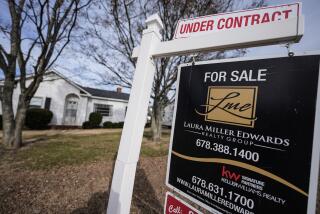O.C. Brokers Not All Sold on Sharing Their Listings : Real estate: Some independents fear that Smith Guide data will be restricted, locking them out of the fiercely competitive market.
- Share via
A broker brouhaha is breaking out in Orange County real estate.
Several small, independent commercial brokers say there is a move afoot by the big firms, which represent an estimated 90% of the market, to restrict distribution of information on buildings available for sale or lease.
Brokers from some of the county’s largest firms acknowledge meeting to discuss how such information is shared, but they maintain that there is no intent to exclude any firm--large or small--from receiving current information on properties.
The controversy centers on the Smith Guide, a computerized listing of all commercial buildings and land for sale or lease in the county. The guide, which was developed seven years ago by former broker James F. Smith, now has 137 subscribing businesses--brokers, developers and banks. The brokerages pay an average subscription fee of $42 per broker each month; developers and banks pay a flat fee of $125 per month.
Independent brokers expressed concern after learning of an invitation-only meeting held at Newport Beach’s ritzy Pacific Club in late July that attracted as many as 20 brokers from major firms operating in Orange County, including Grubb & Ellis, Daum Commercial Real Estate Services and CB Commercial Real Estate Group.
Other brokerages represented were Sher-Voit Commercial Brokerage Co., the Seeley Co., Collins Fuller Corp. and Cushman & Wakefield, according to Bill Lee, president of Lee & Associates, who was at the meeting.
The main topic of discussion, the independents say, was whether the large brokerages would continue subscribing to the Smith Guide. There was also discussion, they say, about developing a separate electronic listing service that would be available only to certain firms.
Lee and others who attended say it was merely an informal gathering of colleagues and competitors to discuss various real estate issues, including the evaluation of several alternatives to the Smith Guide. They stress that there is no plan to exclude any other Orange County brokerages from receiving information on available properties.
Smith was not invited to the gathering. He spoke cautiously in a recent interview, saying that he is worried about offending any of his customers, large or small. The Fountain Valley publisher said that as a result of the meeting, and subsequent discussion of the topic, he has “felt pressure to stop providing services to the independent brokerages, developers and firms outside the county.”
*
Representatives of several of Orange County’s 46 independent commercial brokerages say the July 29 meeting was a restricted strategy session and that they are angry, not just because they were not invited but because of what was on the agenda.
“Their intent is to control their inventory and not let people access it. By doing so they can drive the independent firms out of business,” said Roger Rhoades, general manager for the Newport Beach office of Bishop Hawk, a commercial brokerage based in Sacramento.
“Because of the real estate downturn, many companies are not making the profits they anticipated,” said Rhoades, who also was not invited. “They can add to their coffers by controlling their inventory information.”
Small brokerages like the one Rhoades operates, many of which are staffed by one or two people and are operated out of small suites or home offices, depend on the Smith Guide for updated listings on available office, retail and industrial properties. They claim they do not have the capability to gather such data themselves.
The controversy over access to building listings comes as brokers face one of the worst downturns in Southern California real estate in years. Prices for premium office buildings continue to fall, and competition is fierce as brokers compete to arrange fewer and fewer deals.
Any move by the larger firms to deny independents access to information would mean “pandemonium and war going on in this county, and it’s not good for our business,” said Rhoades, with 20 years of real estate experience in Orange County.
Chuck Noble is one of those who did attend the meeting. It was “a meeting to discuss how we share current inventory information with each other,” said Noble, managing principal with the Orange office of brokerage Lee & Associates.
Noble said there is a concern that information collected by the larger brokerages at significant cost and effort then goes into the Smith Guide, which is available to competitors throughout Southern California.
“Some brokerage firms said maybe we should stop doing that and share information only with each other,” he said. “There are some people in the industry--not necessarily me--who think that, as more and more of that information gets out, they are less effective as a firm.
“Personally, I see a trend where real estate firms that collect data are going to go internal with it. Then, by law, are you required to let broker John Doe, who works out of his home, tap in?”
The answer is not simple.
Paul Roark, a lawyer with the Federal Trade Commission in Los Angeles, said there is nothing unlawful about a group of real estate companies getting together to create their own multiple-listing service.
“The problem is whether the membership requirements in a new listing service are an unreasonable restraint of trade” under the Sherman Act, one of several key federal antitrust laws, said Roark. “The meeting of the firms doesn’t violate any rules, but if they create a multiple-listing service which has market power, they must have reasonable and non-discriminatory membership terms.”
He said that if the firms created an electronic listing service, and smaller brokers had to buy costly computer equipment to tap in, that would probably not be unreasonable. But charging costly monthly fees for the listings could be, he said.
Jeffrey Thomas, an antitrust lawyer with the Irvine office of Gibson, Dunn & Crutcher agreed, and said there was nothing wrong with the brokerage firms meeting, “as long as their agreement to create a new listing service does not harm competition or drive out realtors who are not part of their group.”
*
In Los Angeles, the nonprofit American Industrial Real Estate Assn. provides a multiple-listing service for commercial and industrial real estate in Los Angeles County. All brokerages that subscribe to the association’s listings must also adhere to the group’s ethics code.
More than 200 Southern California companies, including most of Los Angeles’ largest commercial brokerages, use that service.
Orange County, however, has no such true multiple-listings service--or ethics code. The only comparable service is the Smith Guide, which is really more of a computerized database that most subscribers use by downloading the information by modem directly into their own computer systems each weekday.
George Spragins, a Grubb & Ellis district manager who was at the meeting, said the Smith Guide has become too costly and that creating lists of available property in-house through his firm’s large research division might save money.
“When Jim Smith first came,” Spragins said, “it was cheaper to use his service. Now it’s not that way. I’m weighing frankly whether we will continue to use the service, and I think a lot of other companies are too.”
Assertions by the independents that they would be excluded are unfounded, Spragins said. Information would still be provided by Grubb & Ellis to the Smith Guide, and to all brokers on a timely basis, he said.
But Nicholas Rogers with Nick Rogers Realty Inc., an independent commercial broker with 21 years of experience in Orange County, said he does not believe it would work that way.
“I think their intent is to create an E-mail network between the major houses who are in the loop,” he said. “They want to not disseminate information to brokers outside the circle.”
Lee, president of Lee & Associates, acknowledges that he personally advocates the creation of some type of E-mail listing network, and said that the meeting was held among the major multiple office firms to evaluate different data-collection options.
“There was no resolution. I don’t know what we’re going to do, but it certainly was not a conspiracy by any means,” said Lee. “The idea that we want to put the Smith Guide out of business or not share information with the independent brokers is just not true.”
But Spragins of Grubb & Ellis says many brokers wish that commercial listings would be kept a little closer to home.
“By Jim selling the service to brokers outside the county, this is different than how the service was originally discussed with us,” he said. “Frankly, I think he should keep this to brokers in Orange County.”
That possibility has alarmed Los Angeles County brokers.
One of those is Patrick O’Healy, a principal with Matlow-Kennedy Commercial Real Estate Services in Long Beach and former president of the industrial real estate group.
O’Healy said he wrote a letter to Smith, and “in the letter I said we were going to take whatever action is needed to be taken to protect our legal right to continue receiving his business.”
Smith said that in his 13 years in the business, he has never heard of such a meeting among major brokerages to discuss listing information.
“That’s why everyone is so curious,” he said. “Times are bad, and there’s a lot of gossip.”
The Listings Loop
The Smith Guide lists all commercial properties for sale or lease in Orange County. It is the primary source of information for both large and small brokers.
The Smith Guide at a Glance * Concept: Provides information on properties for sale or lease. Similar to multiple-listing service used by residential brokers. * Information: Three-way property listings by size, city or street name. Includes land and some properties outside the county. * Subscribers: 137 * Founded: 1986 by James F. Smith, former broker * Headquarters: Fountain Valley Commercial Market Overview:
In the past three years, commercial real estate sales have plummeted in all categories, intensifying competition between brokerages. Annual sales in millions:
Office Industrial Retail Apartments 1990 $293.5 $345.4 $241.4 $547.1 1991 254.2 324.0 216.0 280.9 1992 223.2 191.3 198.2 252.7 1993* 17.7 26.4 31.7 42.0
* 1st quarter Sources: Comps Inc., Grubb & Ellis, the Smith Guide; Researched by JANICE L. JONES / Los Angeles Times
More to Read
Inside the business of entertainment
The Wide Shot brings you news, analysis and insights on everything from streaming wars to production — and what it all means for the future.
You may occasionally receive promotional content from the Los Angeles Times.










